Last week I did something quite unexpected: I bought a 2004 X5 equipped with a six-speed manual gearbox, the sport package, and the towing package (the Triple Unicorn). It was in unbelievably nice condition for its 270,000 miles, but had a bad right front lower control arm. The goal of the purchase was ostensibly to have a vehicle I could use to both tow and haul stuff, while also being something that I would actually enjoy owning and driving every day (e.g., not another Suburban that would occupy half my driveway until the handful of times I needed to use it).
Well, goal, schmoal; at some point, you simply buy something, fix it, drive it, live with it, see if you like it, and sell it if you don’t. They’re cars, not children. As Sinatra sang, “Maybe I’m right, and maybe I’m wrong.”
Task One was that control arm. Actually, belay that; Task One was that, when I drove the car home and pulled it into the driveway, I absentmindedly rolled the driver’s-side window all the way down to say something to Maire Anne, forgetting that even though the window worked, it was a little wonky. Once it was down, I couldn’t get it back up. It was 40 degrees out, the sun was going down, and I had no choice but to pull the door panel off. Fortunately, the window just needed a little help getting back up. At some point, I’ll properly address it and the two rear regulators that are completely broken.
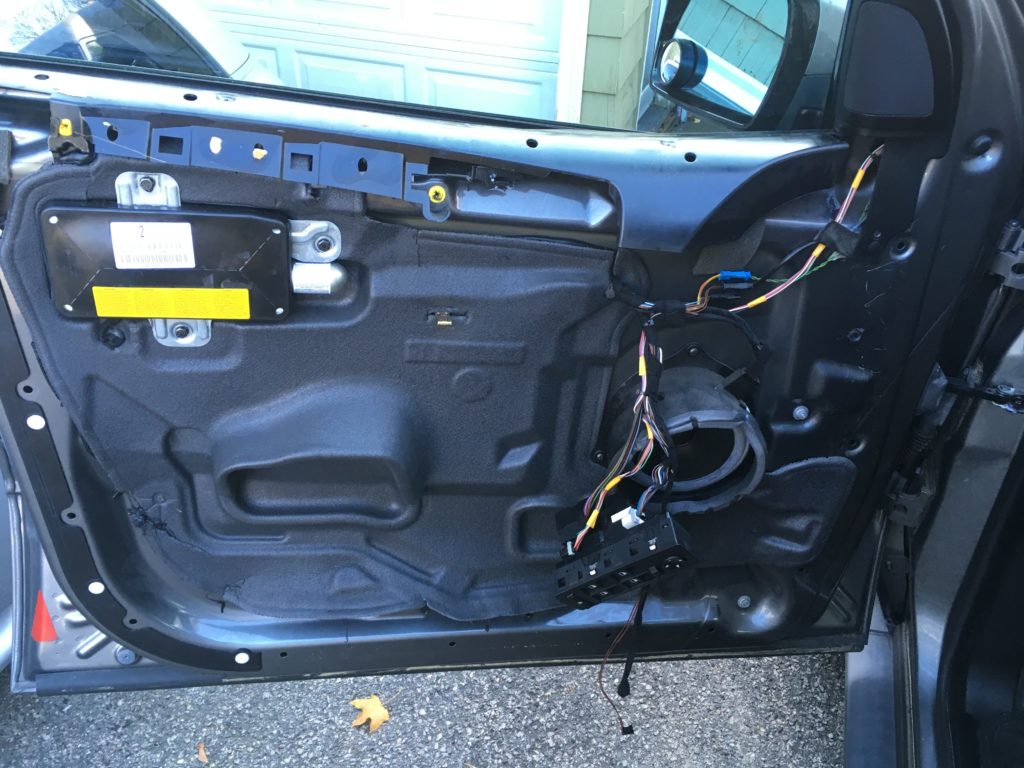
Getting to know you, getting to know all about you….
Back to the lower control arm: I’d discovered it during initial pre-purchase inspection by jacking up the car’s nose and grabbing the wheels at 3:00 and 9:00 o’clock to test for play—and play it had, in spades. When I briefly test-drove the (unregistered) car, I could feel the slop. It was when I drove it home on the highway, though, that I fully realized how bad it was: Anything but egg-on-the-brake-pedal braking caused the car to shudder violently and pull so strongly to the right that I wondered if the car also had a seized front caliper or a plugged flexible brake hose. The seller had bought new pads and rotors for the front and rear, indicating that someone thought there were braking issues, but for some reason he had installed only the pads. I thought that I’d get the car in the garage, replace the control arm, and while the nose was airborne, get the new rotors on and inspect the calipers.
Unfortunately, cold weather was moving into New England, and the geometry of my garage is such that in order to get the X5 into it, roll the door closed, put the heat on, and have room to jack up the front of the car, I had to move both the ’73 3.0CSi and the Lotus Europa outside. The 3.0 would take it in stride like the gorgeous classy 46-year-old that she is, simply rolling her eyes at me for my questionable priorities, but I knew that the Lotus would throw a hissy fit at the cold temperatures.
By the time UPS delivered the lower control arm, the temperature had dropped to 15 degrees. The forecast for the next day was an almost balmy 40 degrees. I waited.
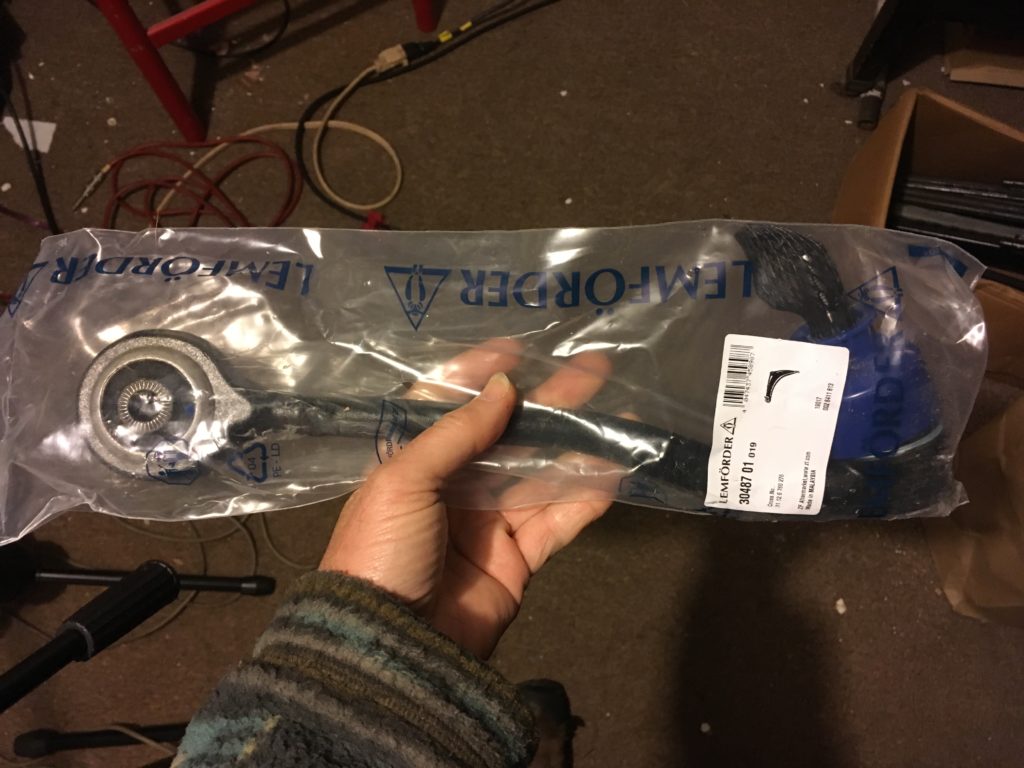
New lower control arm in hand. Let’s get it on—tomorrow.
First, I should say that accepted wisdom is to replace front suspension and steering components in pairs, and that really, the smart thing is to embrace the “do it once do it right do it all” approach and tackle all of the normal-wear-and-tear front-end components at once.
It will surprise no one to learn that I did not plan to do that.
Quite the opposite: I’d just bought a car that had 270,000 miles on it. I wanted to fix what immediately required fixing so that I could begin to drive it, suss it out, see what it really was and what it really needed, and determine whether or not I even liked it.
I ejected the lithe E9 and the anorexic little Lotus into the cold, and piloted the anything-but-svelte X5 into the garage, canting it to the left so I had room to work on the right front wheel.
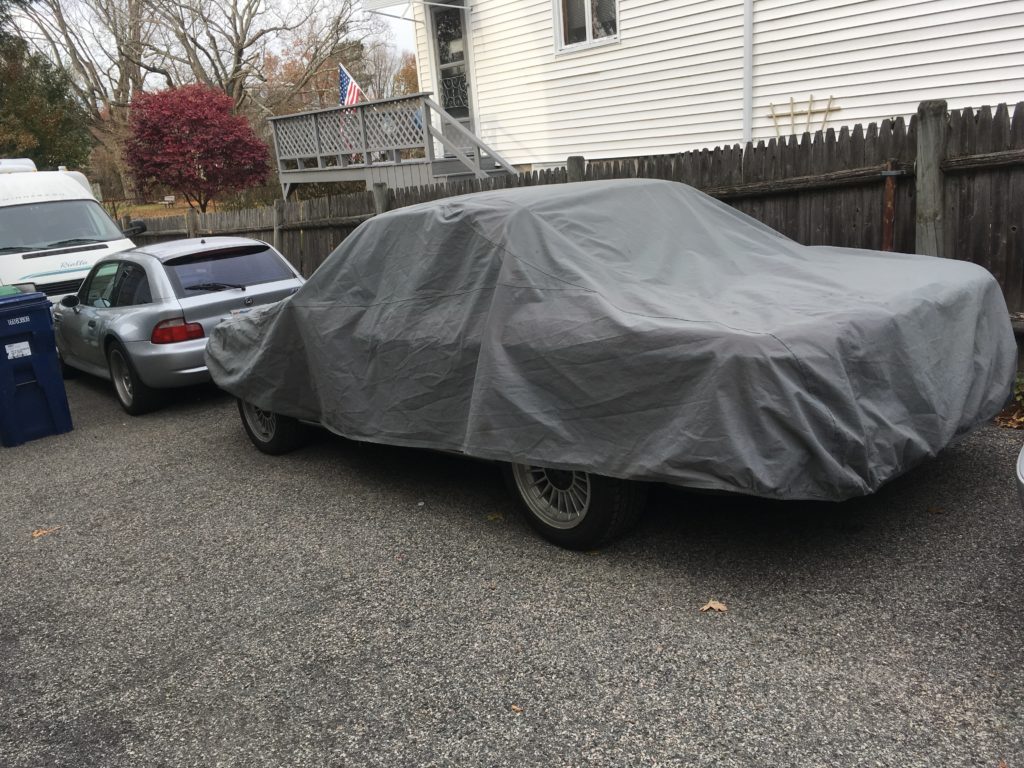
The mature, reasonable E9 said, “You’re going to make me sit OUTSIDE? Oh, all right. Let me throw on a sweater.” What the Lotus said was unprintable.
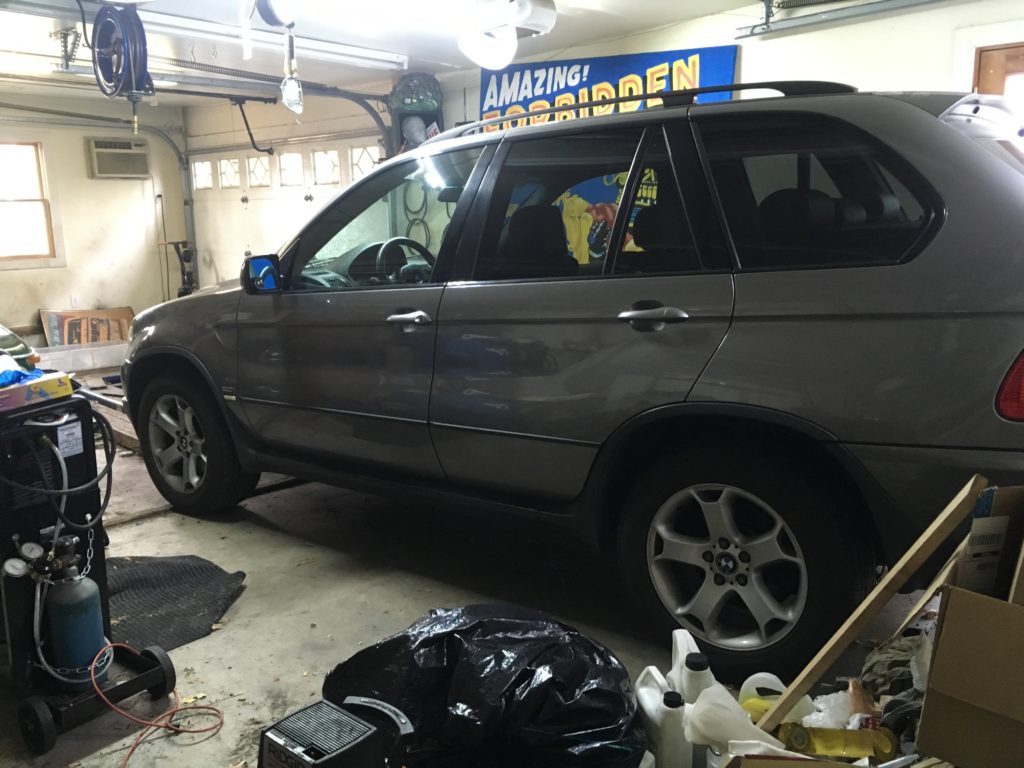
The X5 felt like a bull in a china shop, if you can call my junk china.
I have a mid-rise scissor lift, but the X5’s weight puts it uncomfortably close to the lift’s capacity, so I did it old-school with a jack and stands and got the nose in the air. As I do with any jacked-up repair, I “double-jacked” the car by jacking it up, setting it on jack stands, and then leaving the floor jack in place for safety.

ALWAYS double-jack a car when working under it. Everyone tells you to never work under a car supported only by a jack, but I’m telling you also to never work on it if it is supported only by stands. Leave the floor jack in place.
Changing the lower control arm (LCA) was almost trivial—until it wasn’t. An 18-mm/16-mm nut and bolt hold the bushing in the frame; simply undo them and draw the bolt out. The tapered ball-joint shaft is held to the bottom of the steering knuckle with a 22-mm nut. The head of the shaft has an Allen key hole in it allowing you to hold it still while you turn the nut with a wrench, but this is one of those repairs that is tailor-made for an impact wrench, as it’ll simply spin the nut off without you needing to hold the shaft.

The 22-mm ball joint nut.
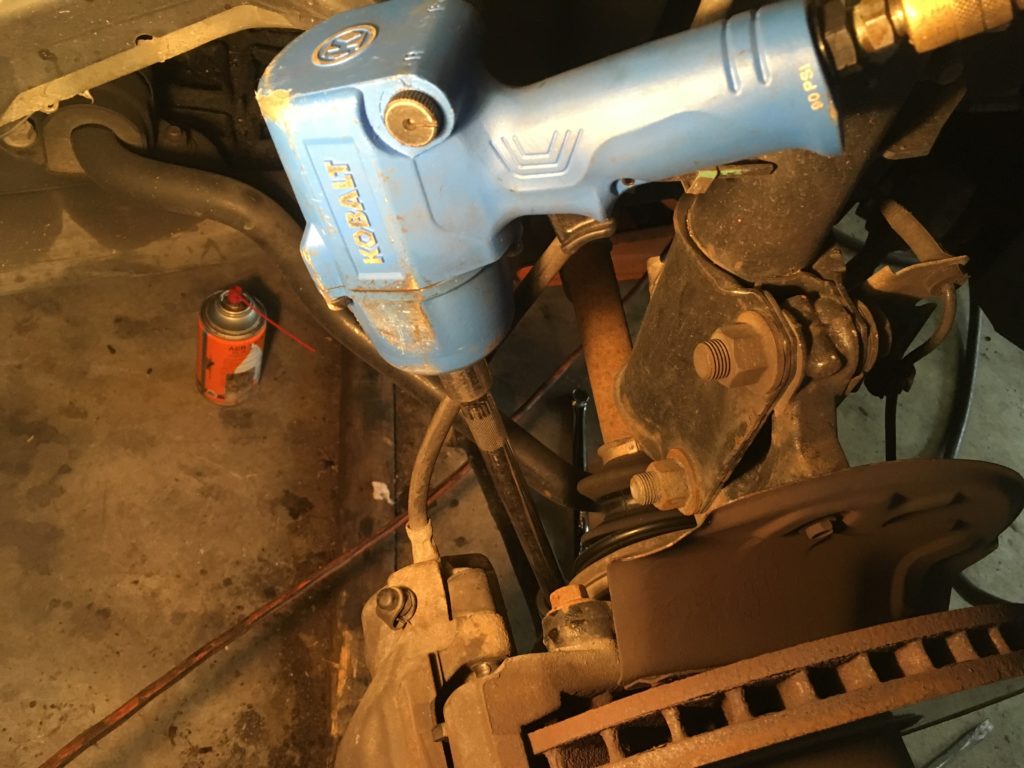
Squeeze trigger, whacketa-whacketa-WHEEEE, and…

Nut be gone!
Then it’s just a matter of pressing the shaft out. When I did the LCAs on the E39 a few months back, I found that the ball joint/tie-rod separators I had for the vintage cars didn’t have quite enough reach, so I bought one that was recommended on one of the E39 forums. I thus expected that I was prepared for the job on the X5.
Imagine my surprise when I found that the separator wouldn’t work. It had the reach, but it wouldn’t yawn open wide enough to press down on the top of the shaft.
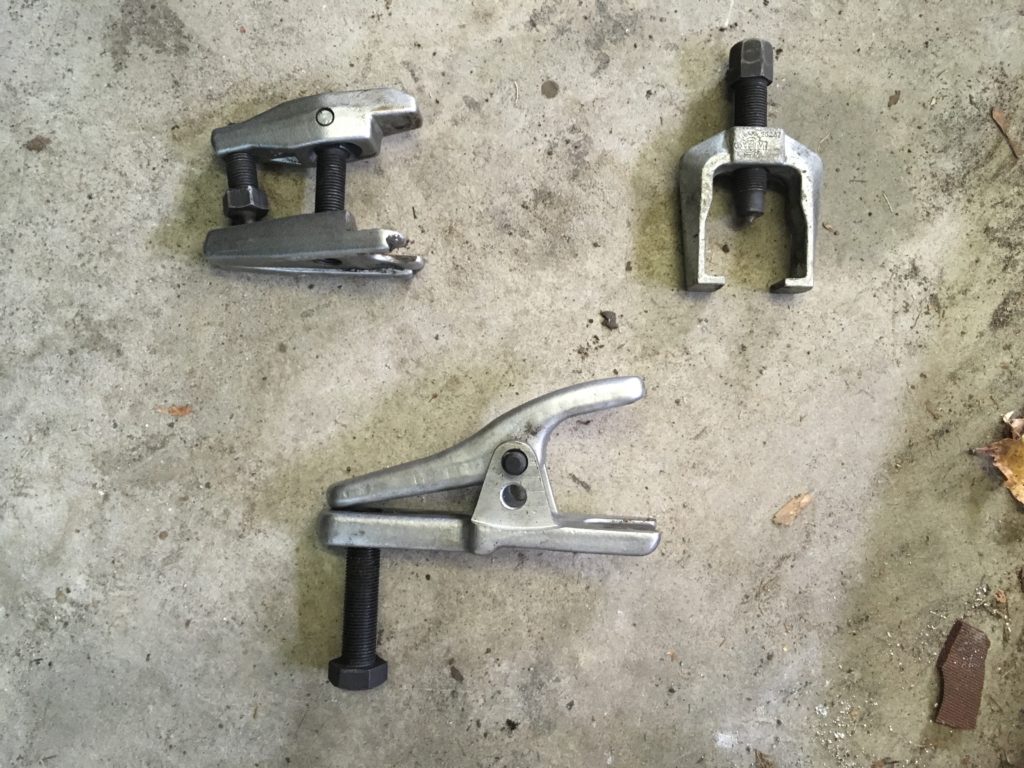
None of these ball-joint separators, including the lower one I’d recently used on the E39, would fit the shaft on the X5’s lower control arm.
I went to a nearby Autozone. The tools they had for rental were identical to the ones I had. An O’Reilly Auto Parts had different loaner tools, but none had both the reach and the opening I needed.
I posted the question to my Facebook BMW friends, and found the answer surprising: “Just smack it.” That’s the sort of thing I used to do 30 years ago, before I learned to use proper pullers. I’ve matured—at least in this limited area— and the idea of beating on front-suspension components is now anathema to me, as I imagine damaging the other components that aren’t being removed. Plus, years back, I once swung at a pickle fork with a hammer, missed, and nearly broke my wrist.
The crowd-sourced opinion, however, did have a basis: Folks said that BMW’s tapered fit on these front-end components isn’t the cold-dead-fingers grip it used to be, and that with a little heat and a little persuasion, tapping downward on the post and smacking the side of the knuckle, the post usually drops out. I tried, but that recipe didn’t work for me.
I recalled that one of my lightly-used air tools was an air chisel for which I have a pickle-fork attachment. I’ve never found it to be a silver bullet for stuck ball joints, but I pressed it into service. After another round of heat, tapping, and vibrating, the shaft gave it up. I did miss the loud BANG! that occurs when a separator like the three pictured above persuades the shaft to release its death grip.
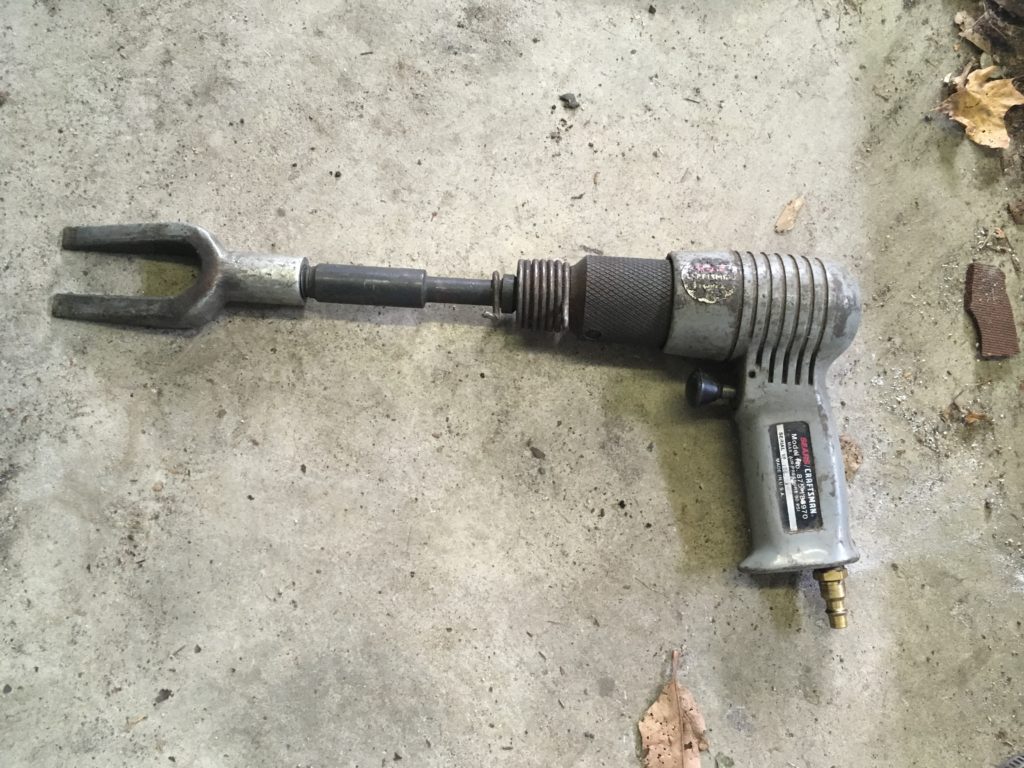
Air chisel with pickle fork, or molar extractor? You be the judge.
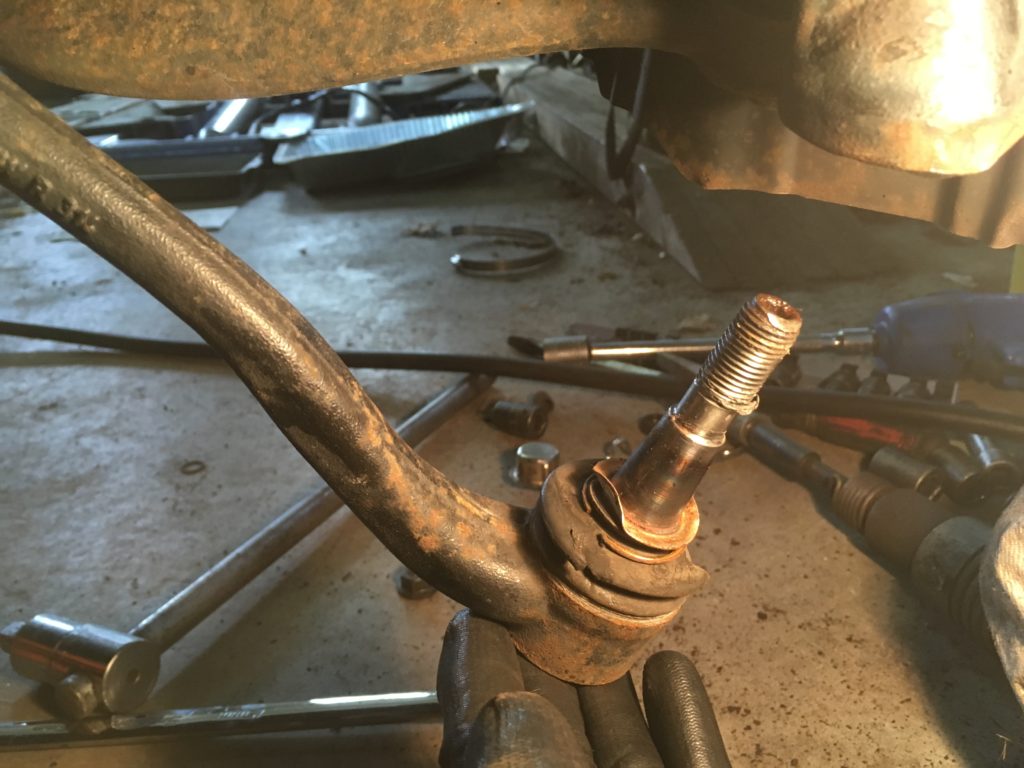
Success!
Installing the new LCA was straightforward. I zipped a new nyloc nut onto the ball joint shaft using the impact wrench, estimating its torque through experience. The slightly tricky part was pre-loading the bushing; the service information says to torque the nut and bolt through the bushing to 74 ft-lbs while the car is sitting on the ground, but I’ve never found that there’s enough clearance to do this; you really need the car in the air. Ideally, it should be on a lift, supported at four corners, with a big vertical bottle jack raising the end of the LCA being installed, but many DIYers make do as follows: With the car double-jacked (jack stands and a floor jack), use a second floor jack under the knuckle to compress the spring and shock and raise that LCA until that corner of the car just begins to rise off the jack stand, then torque down the bolt through the LCA bushing. I’m not advising that you do this; in fact, my inner lawyer is advising that you don’t do it. If you have any doubt whatsoever about your ability to do this safely, don’t do it. You can install the LCA and lightly snug down the bushing bolt, then take the car to a garage and have them put it up on a lift, load the bushing, and torque the bolt down. Good? Good.
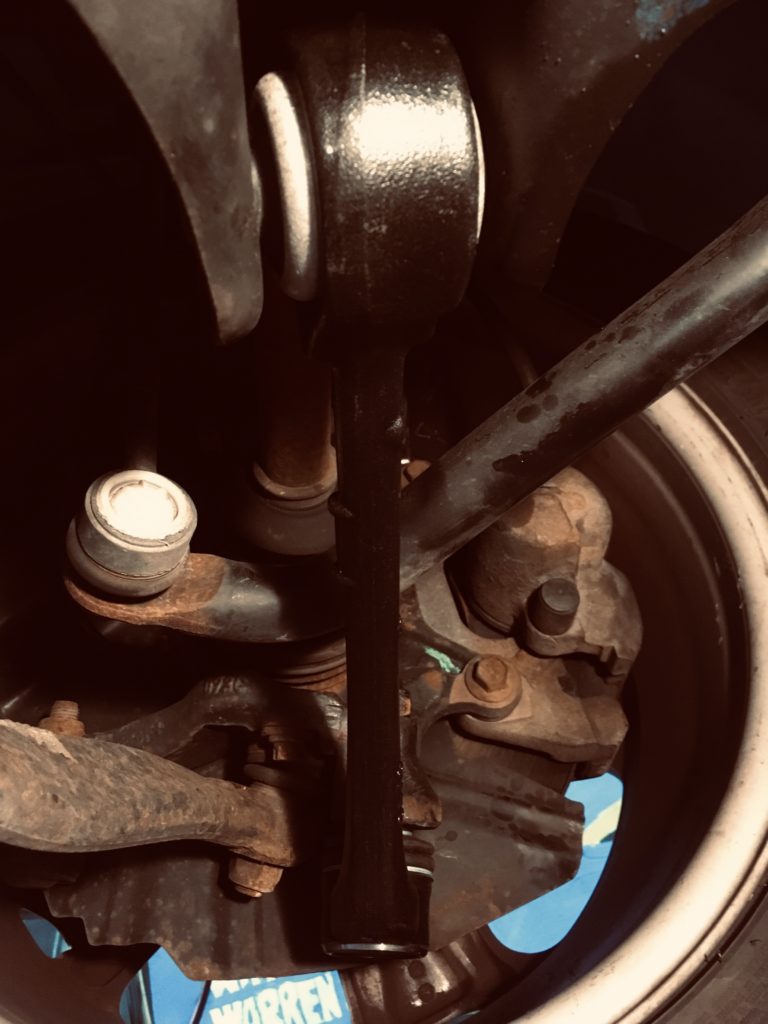
I replaced just one steering component of many, but it was the one that was bad.
Before I finished up, I wondered: The big beefy car was already nose-up in the warm garage, with its sisters shivering out in the cold. Should I take the opportunity look at the front brakes to see why it was pulling to the right? It wouldn’t take me long to pump some brake fluid through left and right front calipers to check for swollen lines, and to pull off both calipers to make sure the pistons moved freely. I could even slap on those new front rotors.
I thought about it for a moment. The car pulled to the right on braking; if the pulling was due to a bad flexible hose or caliper, the bad components would need to be on the left. I decided that since the car pulled on braking to the same side as the bad control arm, odds were that they were two different symptoms of the same problem. Besides, if I was wrong, it wasn’t really that much work to pull the car back in. I rolled the dice, let the car down, backed it out of the garage, and put the cool cars back in, thereby restoring automotive order to my own odd corner of the universe.
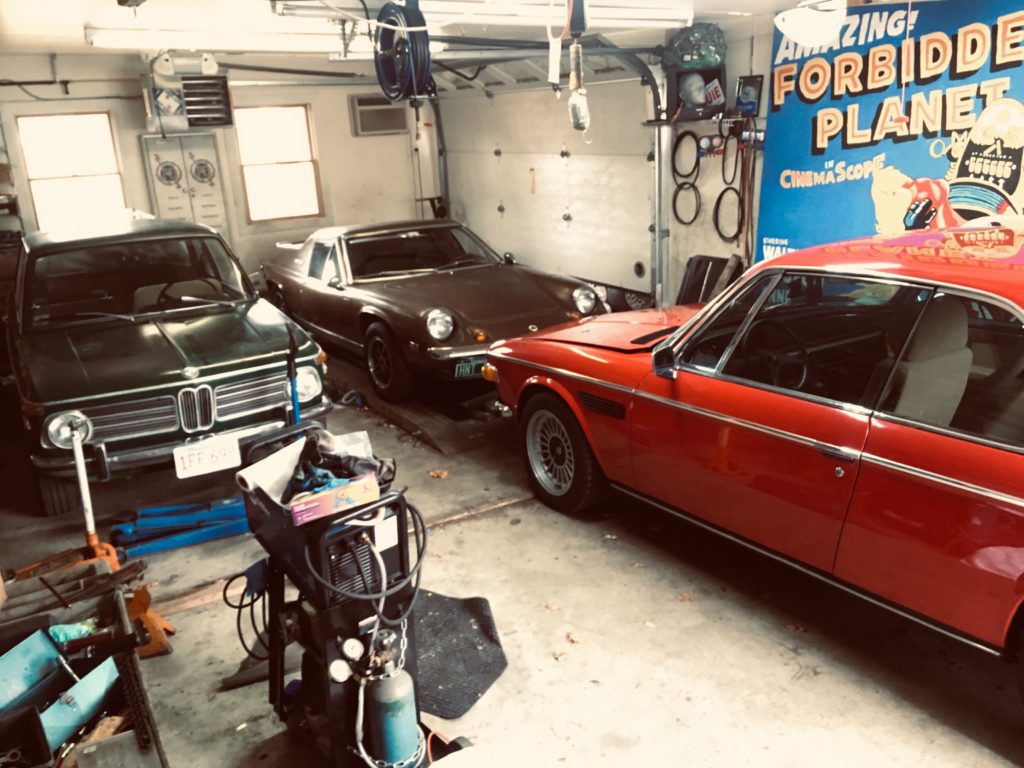
Everything back to normal. Well, my normal.
I came back inside the house and discovered that the registration paperwork from my insurance agent had arrived in the mail, allowing me to run down to the registry and make the X5 legal. Suddenly I was faced with having to make an immediate choice that I had not really thought through: Should I swap the plate with my 2003 E39 530i five-speed sport, pulling it off the road and leaving it in the driveway, or should I have both the E39 and the X5 on the road at the same time?
I made a snap decision: I checked off the “transfer” box, pulled the plate off the E39, put it on the X5, and drove the X5 to the registry (legal since I had the paperwork in my hand).
The Watertown DMV is perhaps five miles from my house on local roads, not a thorough highway drive but far enough to get some sense of whether I’d gotten the repair right. It appeared that I had; the X5 rode and drove fine, the shuddering was gone, and even on hard braking, the car didn’t appear to pull at all. I sighed with relief.
But the other feeling I had was What the hell are you DOING? You took the E39 530i stick sport—the car you routinely describe as the best daily driver you’ve ever owned—off the road, and replaced it with a completely unproven X5 with 270,000 miles on it! Granted, it’s a six-speed sport-package car in incredibly good condition, but what the hell do you think is going to happen—that it’s going to cross some magic threshold into mileage territory where it exudes anti-mileage antibodies and self-heals like a biological system?
Let’s talk about this, because I do feel like I need to defend the decision, mostly to myself.
I happened into the E39 nearly four years ago, dead in a snowbank, needing only a battery and replacement of a corroded rubber vacuum line to clear the evap code and extinguish the check-engine light. I bought it because I’d been daily-driving my dying Suburban, the E39 was a dirt-cheap five-speed sport-package car, its silver exterior and black sport interior looked like they had half the car’s 183,000 miles, and when I drove it, I instinctively liked it. For $1,500 bucks, it seemed like a good interim car. I was more right than I ever expected to be about everything except the “interim” part. Four years is a long time for me.
Although I like the utility of BMW wagons, I tend to prefer smaller, lighter, snappier cars like the Z3 and the M coupe. So I didn’t expect to love something the size of an E39 sedan—too big to be tossable, too small to be as useful as a wagon. Initially I joked that it was my “old man car” because I’d say things about it like, “It’s smooth. It’s quiet. It’s got great seats and a great stereo.” But the longer I owned it and drove it, the more I liked it. The 228-hp M54B30 has just the right amount of power—not yeeeeeeeHA power like its eight-cylinder brethren, but it doesn’t have the V8’s timing-chain-guide issues, either. The sport seats allow me to pound out hundreds of miles without the Tempur-Pedic back pillow I need when driving in less-supportive seats. Because it’s a rear-wheel-drive car, the steering, while not being as light as the smaller cars, isn’t heavy like the all-wheel-drive was in my E46 325xi wagon. And while not being a wagon, the E39’s fold-down rear seats allow it to easily swallow sets of wheels and tires.
And repair-wise, the car has been great. It needed a final-stage-unit (FSU) resistor pack early on, but other than that, I’ve replaced very little. On most daily-driver BMWs I buy that have no repair history, I pony up the $600 and replace the radiator, water pump, expansion tank, thermostat, hoses, idler pulleys, and belt, but when I bought the E39, I was still working at Bentley Publishers in Cambridge, had a local six-mile commute, and thought, “AAA can just tow the thing back to my house if it breaks. This time, why don’t I do what most people do and not fix things that aren’t broken?” It kept not breaking, and I kept driving it. Over time, I became less shy about jumping in it and pounding out 300 miles to, say, look at another car in northern Vermont. It just kept on going. It still is going. For all of these reasons, yes, the 2003 E39 530i stick sport unexpectedly wormed its way into my heart.
However, last spring, the car’s front end got squirrely. I replaced both front lower control arms—one of which, like the X5, clearly had developed a bad ball joint—and that helped, but there’s still shaking on braking, indicating that the upper control arms need to be replaced as well (rotors appear to be fine). And the pixel display has gotten so bad that, when the car beeps, I have no idea what the display is saying; it could be you idiot the engine is about to blow up (yes, I regularly check the oil level on the dipstick). And at annual state inspection time, I can’t read the car’s mileage; I have to plug a scanner into the OBD-II port to get it. And the cooling system still hasn’t been done. I recently looked at the date code on the radiator tank; it says 2003. Original. Yeesh.
In contrast, the X5, despite its high mileage, came with a stack of receipts from the three previous owners showing a recent water pump, expansion tank, alternator and belt, and many other things, and in general appears to be a well-maintained car. So yeah, it’s a little hyperbolic of me to say that I’m replacing a proven reliable daily driver with an unknown interloper with 270,000 miles.
When I had my black E39 sport wagon years back, it got so needy that its needs approached that of an enthusiast car when I needed it to be a daily driver, so I sold it. The E39 530i hasn’t gotten anywhere near that needy, but its deferred-maintenance issues are piling up. I’ll admit that with it now sitting in my driveway with the plates off, its future is a bit unclear. If the X5 crashes and burns reliability-wise, I can simply re-register the E39 and hope it forgives me. Or maybe, with the pressure off daily-driver use, the E39 can elbow its sisters out of the garage and get some maintenance love, though once the snow falls, that’s a tall order.
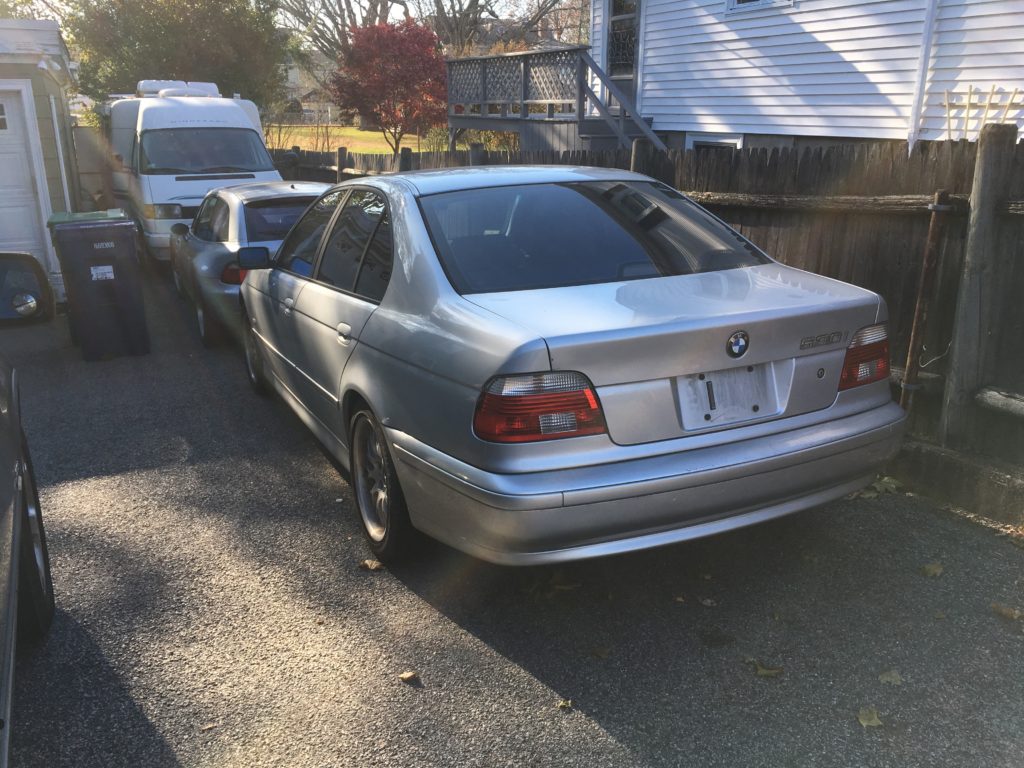
The E39, un-plated and in limbo.
Last night I took the X5 for its first post-repair highway drive. Hard braking at highway speeds reveals a slight shudder that would probably be addressed by upper control arms, but it’s slight, an order of magnitude less than the shudder I’ve been living with in the E39 for months. There’s a small amount of vibration likely due to bent and/or out-of-balance wheels and tires, which is to say that it’s no different from every other BMW I’ve owned for the past two decades. On uneven surfaces, there are some unforgivable rattles coming from the rear doors with broken window regulators and propped-up windows; no surprise there. There’s a minor knocking from the steering column—I assume the column U-joint—when the wheel is rotated during parking. That’s about it.
While I was pulled toward the X5 in general by the possibility of owning something with both a stick and a trailer hitch, and pulled into this one in particular due to the unicorn-rare combination of options, the inky blackness of the interior (including black trim and an Alcantara headliner), which is like sitting in a sensory deprivation chamber, in a good soothing way, and the car’s extraordinary condition, I did not seek out a truck, SUV, or a crossover vehicle in order to get a high seating position. That’s the last thing I want. Give me a low sedan or sports car any day. So I definitely don’t regard that as a plus with the X5. And even in the short time I’ve had it, the heaviness in the steering caused by the all-wheel-drive, as expected, rubs me the wrong way. And the car’s general beefiness isn’t really to my liking. I’m much more conscious while pulling it into parking spots.
But the fact that the car shares the same M54B30 engine with the E39 530i makes it feel very familiar. Like the E39, the X5 has exactly the right amount of power for me. It’s a heavier vehicle, so I assume that part of this trick is achieved by gearing. I believe that the X5 3.0i has a 4.10 rear end. The six-speed in this car isn’t the double-overdrive “sixth only above 80” that many folks expect. First gear is pretty low, feeling almost like a stump-puller. The other gears feel natural. And the one ramp I took, uh, enthusiastically left no question that it’s a BMW.
Main takeaway: If the X5’s reliability is reasonable, I think I can live with it as a daily. It feels familiar enough that I can overlook its bulk and heavy steering in favor of its way-cool interior, towing capability, and stuff-hauling potential. And I’m sure I’ll appreciate the all-wheel drive, heavy steering or no, when the white stuff falls. See? I can be a reasonable guy.
And now, the naming of the beast.
I never used to name cars, but the practice has snowballed with me in recent years. After all, you have to call them something, and if you don’t name them, you just call them “the X5” or lengthy convoluted things like “the 2003 E39 530i stick sport” as I’ve said above. Since the X5 (see what I mean?) has the unheard-of-rare combination of six-speed manual transmission, sport package, and towing package, I referred to it last week as a “triple unicorn.” My ex-colleague Maury Walsh recommended that I name it Triceratop, going for the singular of the three-horned dinosaur species. I liked that, as it fits with the car’s beefy stature and rare nature. One could also argue that, having no navigation system and no sunroof, the car is a penta-unicorn (Pentacorn?). A family member offered the hip superhero-sounding Triple-U.
But I think I’m going to go with the offering from my friend Scott Aaron. Scott, who named my ’72 2002tii Louie Agave (“sounds like a mobster you don’t want to mess with”), looked at the X5’s bulk, swagger, and potential to cause trouble, and came up with Bluto, as in Bluto Blutarski, the character John Belushi played in Animal House. So if it pops a hose or blows a seal and sprays stuff everywhere, we can all say, “I’m an X5. Get it?”
Bluto it is.
Of course, the first time the thing strands me and I’m facing a repair that’s involved enough that I’ll need to either pull two fragile cars out of the garage and into the howling snows of winter for days, or fork over thousands of dollars to a repair shop, we all know that I’ll utter the real name of the beast: “That @#$%ing X5!”—Rob Siegel
Rob’s new book, Resurrecting Bertha: Buying Back Our Wedding Car After 26 Years In Storage, was just released and is available on Amazon here. His other books, including his recent Just Needs a Recharge: The Hack MechanicTM Guide to Vintage Air Conditioning, are available here on Amazon. Or you can order personally-inscribed copies of all of his books through Rob’s website: www.robsiegel.com.





















